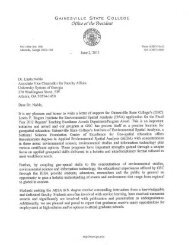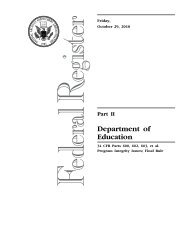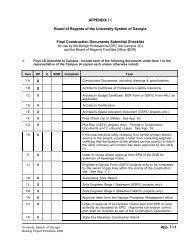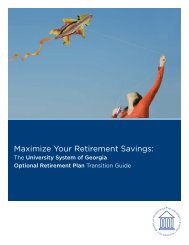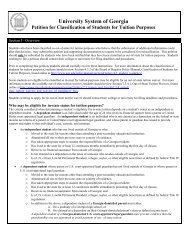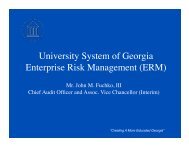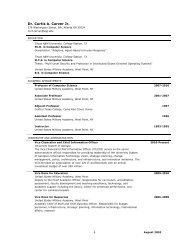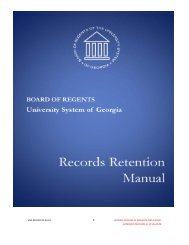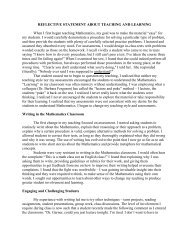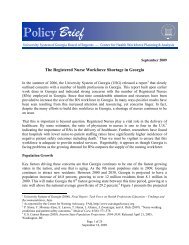75 years of transforming lives - University System of Georgia
75 years of transforming lives - University System of Georgia
75 years of transforming lives - University System of Georgia
Create successful ePaper yourself
Turn your PDF publications into a flip-book with our unique Google optimized e-Paper software.
<strong>75</strong> YEARS OF TRANSFORMING LIVES<br />
1932-1950<br />
Birth, Conflict and Constitutional Status<br />
1932: The <strong>University</strong> <strong>System</strong> <strong>of</strong> <strong>Georgia</strong> is Born<br />
The transformation <strong>of</strong> higher education in <strong>Georgia</strong> began with the election<br />
in 1930 <strong>of</strong> Richard B. Russell Jr. as governor on a state government reform<br />
platform. As a result, the Reorganization Act <strong>of</strong> 1931 led to the creation<br />
<strong>of</strong> an 11-member Board <strong>of</strong> Regents to provide governance to the newly<br />
formed <strong>University</strong> <strong>System</strong> <strong>of</strong> <strong>Georgia</strong>. Among the Board’s first challenges<br />
were to shift governance from individual institutions to the interests <strong>of</strong> the<br />
state as a whole; to redefine the status <strong>of</strong> the <strong>University</strong> <strong>of</strong> <strong>Georgia</strong>, which<br />
had been the lone guiding force in education in the state; to assess a poorly<br />
planned core curriculum; to manage a very significant deficit; and to gain<br />
control over a disorganized and uncoordinated approach to meeting the<br />
higher education needs <strong>of</strong> all <strong>Georgia</strong>ns.<br />
The Budget Process is Unified<br />
An early accomplishment <strong>of</strong> the Board <strong>of</strong> Regents was to present a unified<br />
<strong>System</strong> budget to the governor and general assembly. The state allocated<br />
a lump sum, which was then allocated to the institutions. This was a unique<br />
and visionary structure, and it paved the way for the <strong>University</strong> <strong>System</strong> to<br />
advance higher education and promote economic development in <strong>Georgia</strong><br />
over the next <strong>75</strong> <strong>years</strong>.<br />
Political Interference Threatens Accreditation<br />
In 1941, longstanding conflicts with Gov. Eugene Talmadge threatened<br />
the autonomy <strong>of</strong> the <strong>System</strong>. The issue boiled over when the governor<br />
managed the firing <strong>of</strong> two respected employees. The result was the loss<br />
<strong>of</strong> accreditation for 10 <strong>University</strong> <strong>System</strong> schools and, for Talmadge, the<br />
loss <strong>of</strong> the governorship as voters reacted to political interference in the<br />
administration <strong>of</strong> the <strong>University</strong> <strong>System</strong>.<br />
Constitutional Status is Achieved<br />
Newly elected Governor Ellis Arnall was committed to preserving a strong<br />
<strong>University</strong> <strong>System</strong>. He was elected governor on a platform that included<br />
removing the <strong>University</strong> <strong>System</strong> from political interference (see above). In<br />
1943, Arnall secured the passage <strong>of</strong> a constitutional amendment granting<br />
the <strong>University</strong> <strong>System</strong> <strong>of</strong> <strong>Georgia</strong> constitutional status. This important<br />
event paved the way for a new era for higher education in <strong>Georgia</strong>.<br />
GI Bill Drives Post-War Enrollment Boom<br />
World War II caused a drop in enrollments, but the passing <strong>of</strong> the GI Bill<br />
sparked an enrollment boom. In 1947, the <strong>System</strong> gained 27,000 students<br />
– half <strong>of</strong> them veterans. The sudden influx <strong>of</strong> students was a driving force<br />
behind a new capital expansion program at institutions statewide, along<br />
with a greater focus on research in sciences, technology and liberal arts.<br />
Schools <strong>of</strong> Veterinary Medicine and Engineering were added at UGA and<br />
<strong>Georgia</strong> Tech, respectively.<br />
1935, Armstrong Atlantic State <strong>University</strong>, Savannah<br />
1948, Southern Polytechnic State <strong>University</strong>, Marietta<br />
First Chancellor, Charles M. Snelling (1932-1933)<br />
Chancellor Philip Weltner (1933-1935)<br />
Chancellor Steadman V. Sanford (1935-1945)<br />
Chancellor Raymond R. Paty (1946-1948)<br />
Chancellor Harmon W. Caldwell (1949-1964)



